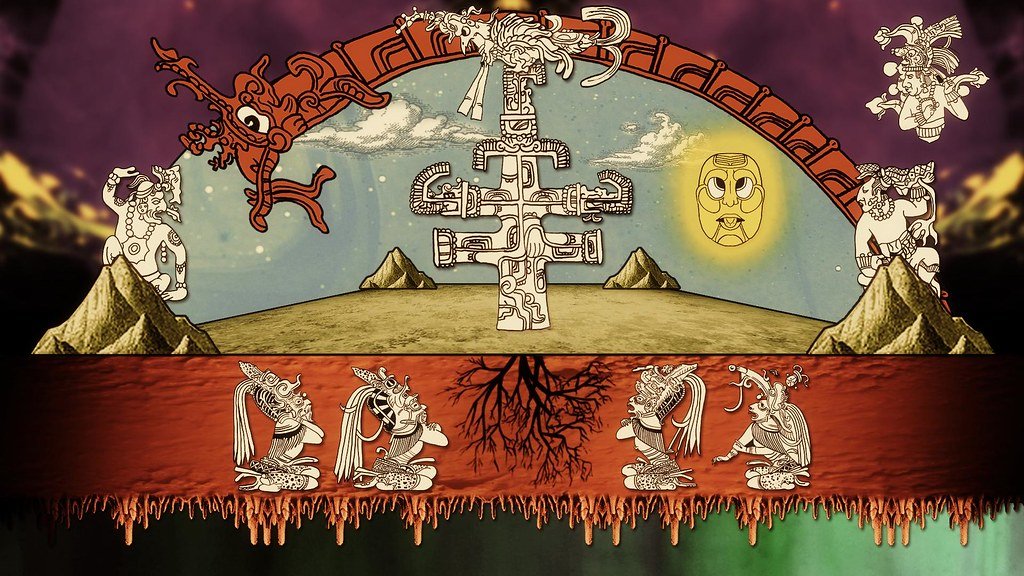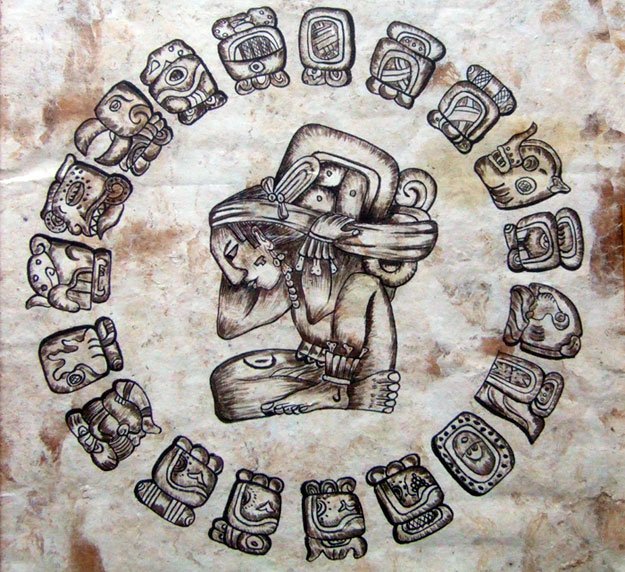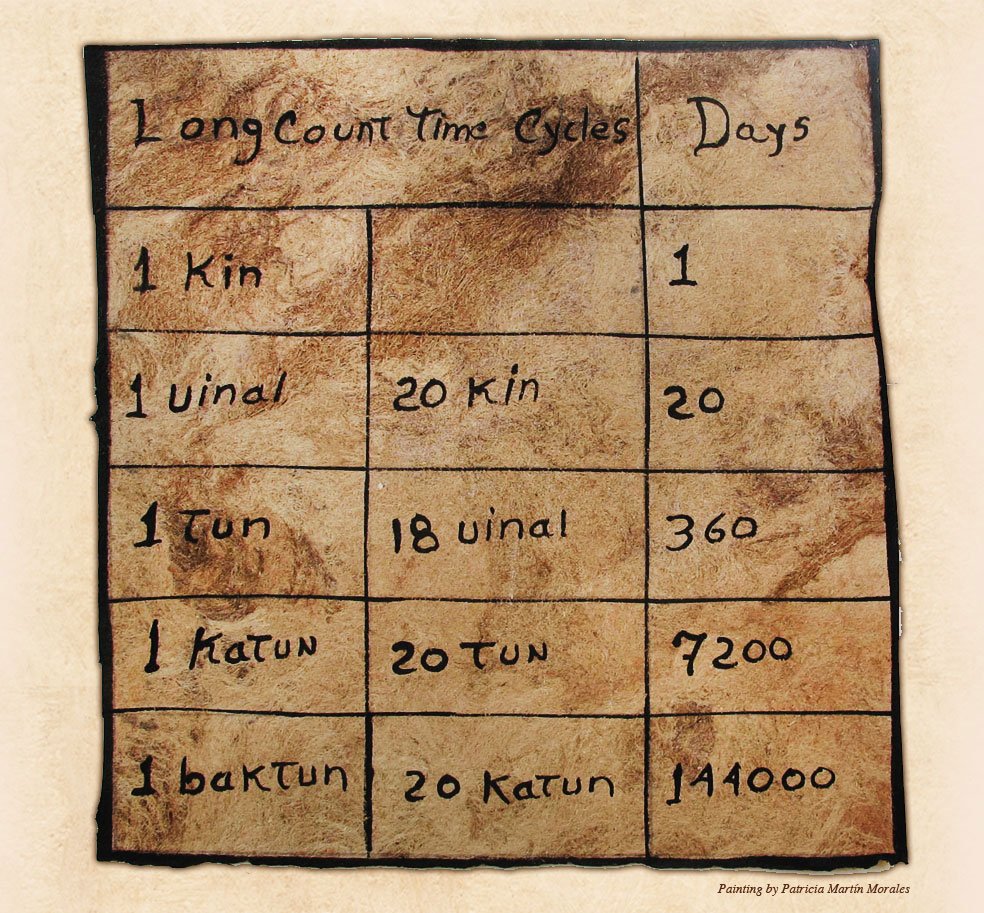Maya Cosmovision
The upperworld was believed to have 13 layers, and each layer had its own god. Uppermost was the muan bird, a kind of screech-owl. The Underworld had nine layers, with nine corresponding Lords of the Night. The Underworld is believed to be the destination of most Maya after death
Maya cosmology is not easy to reconstruct from our current knowledge of their civilization. It seems apparent, however, that the Maya believed Earth to be flat and four-cornered. Each corner was located at a cardinal point and had a colour value: red for east, white for north, blue/black for west, and yellow for south. At the centre was the colour green.
Some Maya sources speak of supreme deity, called Itzamná, the inventor of writing, and patron of the arts and sciences. His wife was Ix Chel, the goddess of weaving, medicine and childbirth; she was also the ancient goddess of the Moon.
Mesoamerican pyramids were typically constructed in tiers. Some people may have imagined the upper world as an upright pyramid joined at the base with a second pyramid, which was upside down. The four corners of the pyramidal bases would have corresponded to the four world directions, with their platforms marking the central world direction and the axis mundi of the entire universe.
The Mayans are animists, meaning that everything was imbued with a spiritual essence or force, including rocks and water. These spiritual essences are honoured and recognised. The gods were the supreme spiritual forces, but even the spiritual essence of a tree or a frog deserved respect. Thus, to the Maya, the entire world they lived in was filled with spiritual forces. At times, the spirits required appeasement; at other times, they are helpful.
The Maya idea of time is cyclical, cycles of creation and destruction, of seasons, of rituals and events, of life and death.
Mayan priests closely track all the cycles important to life. Priests keep track of the calendars, the Solar Calendar with its 365 days, the Sacred Calendar of 260 days and the Long Count Calendar. They also interpreted the cycles, looking for clues and prophetic inspiration. Priests determined the days propitious for rituals and ceremonies. The priests who kept track of cycles and calendars were expert mathematicians and astronomers. Maya cosmovision agree that gods imparted meaning to celestial patterns from which their priests could foretell events.
Some of the calendars still in use, from smaller to greater cycles are:
The Cholq’ij / The Haab / The long count
cholq'ij
Sacred Calendar of 260 days to determine life purpose. A cosmic-telluric relationship to bring balance and harmony to life on Earth.
The Cholq'ij “Book/Count of the days” or “Thread of the days”, begins on B'atz' and ends on Tz'i' for the K'iche' people or from Imox to Ajpu for the Yucatec people. This “Book/Count of days” is used today as it was put together by the ancient Mayas more than 5000 years ago BC.
It has two main applications, the first: it locates moments for collective activities, ceremonies, celebrations for spiritual strengthening.
The second: it has an individual application to identify the natural behaviour or way of being of people through their nawal/nahual/essence, that is, the basic, positive and negative psychological traits.
The Cholq'ij is immersed in the universe and in the elements of mother nature, necessary for the cycle of life and other fundamental aspects of our culture; the feminine energy (I'x), the dawn (Aq'ab'al), and the death (Kame).
It is formed by 20 days rotating 13 times. Placing the number before the glyph.
Is 20 types of basic personality with 13 levels, making it 260 types and levels of personalities
In these 20 sacred glyphs are expressed all of the basic forces of creation and destruction, the good and the bad that are in the world, in society, in the family and what is in the heart of the human. The unity of such forces in the individual lives depends on the course of life and destiny.
The 20 star-glyphs or days of the Cholq'ij are: Imox, Iq, Aq'ab'al, K'at, Kan, Kame, Kej, Q'anil, Toj, Tz'i', B'atz, E, Aj, I'x, Tz'ikin, Ajmaq, No'j, Tijax, Kawoq, Ajpu.
The Cholq'ij determine one's life purpose. Although this process is intricate and requires years of training, it is often helpful to know the energy at the time of birth, the equivalent of what is known as your “heart sign”. To find out what this energy was at your time of birth, you may check a calendar conversion tool and then look up your sign or send a request to me. This tool can also be used to learn about the energy of any given day so that we may plan and work to be in better harmony.
Why are the numbers 13 and 20 used? The number 13 is sacred because the most important joints in the body are; the ankles, the knees, the hips, the wrist, the elbows, shoulders and one at the neck. Is the number of pulsating rays of lunar radiant energy from new to full on Earth. 13 Full Moons every solar cycle. 13 Meridians as well and 13 musical tones including holds.
As far as the number 20, this symbolises the 20 fingers of the human being; 10 on the hands and 10 on the feet. 20 is the smallest fraction of the maya counting system where a physical human form can manifest on earth.
HAAB
There are 19 months in the Haab Calendar which followed the solar cycle of 365 days. Is 18 months of 20 days and the final month called Uayed (Wayeb), of 5 days. The 5 nameless days of Wayeb are times of uncertainty. This calendar is used for seasons, agriculture and keeping track of the Sun. Months are associated with the earth, maize seed, and dry seasons.
The Haab is the most similar to the calendar we use today with 365 days in its count that's based on solar observations.
When used together, the Haab and Tzolkin Calendar create a larger 52-year cycle called the Round Calendar that was used not only by the Maya but also by the rest of the Mesoamerican cultures. It's also called the "vague" year because, unlike the Christian calendar, it does not include a leap year.
The Haab is made up of 18 months of 20 days each and a final short month of only 5 days. Together they form the 365-day, solar-based year. As with the Cholq’ij/Tzolk'in, each day is represented by a number-glyph combination, but the numbers are now 20, one for each day of a 20 day month.
The first number of any given month is mathematically in the place of zero (a concept with which the Maya are aware), but written hieroglyphically as "seating." The patron deity of the month assumes the throne on day zero and stays for the next 19 days. The final five days of the Haab cycle are the 19th month, called Wayeb. These are unpredictable days, not for planning important events or traveling away from home.
The Maya Solar Calendar or Haab has a cycle of 360 days plus 5 purification and rebirth days + hours needed to conclude the orbit cycle around the sun. The current Gregorian Solar Calendar deals with this time/space portion by adding one day to the month of February every 4 years of 365 days
The 18 Maya months are known, in order, as: Pop, Wo, Sip, Sots', Sek, Xul, Yaxk'in, Mol, Ch'en, Yax, Sak, Keh, Mak, K'ank'in, Muwan, Pax, K'ayab, Kumk'u and Wayeb.
In today's Gregorian Calendar, an adjustment for this discrepancy was made by making almost every fourth year a leap year, when an extra day—a leap day—is added on the 29th of February.
long count
The Maya Long Count is an astronomical calendar, with each cycle lasting 5200 years. It includes the Haab & Tzolk'in Cycles. It is tracking the beginning of the Maya civilisation.
The Long Count, for which we do not know the Maya name, is used to know the position & astronomical power of the Sun in a Tun (1 year), in a K'atun (20 years), in a Bak'tun (400 years) and in an Oxlajuj Bak'tun (5,200 years)
The Long Count calendar is counting the number of days from a starting date that is generally calculated to be August 11, 3114 BCE in the Gregorian calendar or September 6 in the Julian calendar or −3113 in astronomical year numbering
According to the Maya astronomical knowledge; periods of time are not the same, each period is unique and different, because the position and power of Sun varies each year. It is here where the importance of the sacred Long Count Calendar gains strength and great value.
The completion of 13 bak'tuns (from August 11, 3114 BCE) marks the Creation of the world of human beings according to the Maya.
The long count is represented as a five place notation system of ascending cycles: kins (days), winals (20-day months), tuns (360 days), k'atuns (20 tuns), and bak'tuns (20 k'atuns).
It is important to note that the long count's version of a year, the tun, is only 360 days, not the solar count of 365. This means that the long count diverges from the Haab by 5 days every year, making it a completely unique and separate cycle.
The largest of the long count's five cycles, the bak'tun, is a period equaling 400 tuns. Many people believe that the full cycle of the Long Count is complete when 13 bak'tuns have passed since the beginning of the creation of this current era, identified as the 4th Sun/creation in the Maya "story of creation", the Popol Vuh.
The ancient Maya would have considered the beginning of a 13th bak'tun a time of great change, a time of the 5th Sun/creation. If every bak'tun (400 years) was a time of great change, then the 13th turn holds special significance, perhaps the beginning of a new era in world history.
A Mayan date would be a combination of all three calendars, for example: 13.0.0.0.0 4 Ahau, 8 Kumku. The 13.0.0.0.0 is the Long Count date, 4 Ahau is the Tzolkin date, and 8 Kumku is the Haab date. At the end of the 13th baktun, the Long Count calendar resets to 0.0.0.0.0.
The ancient Maya reportedly believed that with each completion of a universal cycle of 5200 years there is a "reset" (an ending, a beginning) of a new era - not just the calendar - hence the doomsday interpretation. This interpretation was encouraged by a 1,300-year-old stone tablet from the Tortuguero archaeological site in Mexico, which contains hieroglyphs depicting the Maya god of creation and war, Bolon Yokte, at the end of the 13th baktun.














